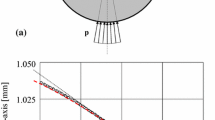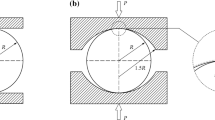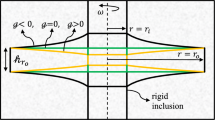Abstract
Thin circular disc rotating about in-plane diametral axis is considered for 2-D stress analysis, as it may be found as flipped coin or Euler disc. Centrifugal force on different points of the rotating disc causes stress distribution resulting in high tensile stress on the diametral axis of rotation, which is confirmed by stress analysis. So, a centre-crack along the rotation axis in the disc would be loaded in pure opening mode. A centre-crack inclined to rotation axis would be loaded in mixed-mode I-II. Stress intensity factors (SIFs, \({K}_{I}\ \&\ {K}_{II}\)) are found for various combinations of crack length and crack inclination using finite element method (FEM). SIFs increase monotonically leading to singularity as crack length approaches diameter. They vary sinusoidally with crack inclination. After modelling the singularity of normalized SIFs, sine functions of crack inclination are fit for non-singular part of each normalized SIF, in which simple polynomials of crack length enter as coefficients of sine function. Error between the fit and FEM data is close to zero, and percentage error for \( {K}_{II}\) vs crack inclination is found to be constant for given relative crack length.










Similar content being viewed by others
References
Timoshenko, S., Goodier, J.N.: Theory of Elasticity. McGraw-Hill, New York (1951)
Akazawa, T.: New test method for evaluating internal stress due to compression of concrete (the splitting tension test)(part 1). J Jpn Soc Civ Eng 29, 777–787 (1943)
Carneiro, F.L.L.B.: A new method to determine the tensile strength of concrete, In: Proceedings of the 5th meeting of the Brazilian Association for Technical Rules 16(3), 126–129 (1943)
Blauel, J.G., Beinert, J., Wenk, M.: Fracture-mechanics investigations of cracks in rotating disks. Exp. Mech. 17(3), 106–112 (1977)
Matsuzaki, R., Ezumi, T.: Stress intensity factor of eccentric rotating disk with internal cracks by photoelastic and caustic methods. Japan Soc. Mech. Eng. 6, 16–22 (2007)
Shariati, M., Mohammadi, E., Rokhi, M.M.: Calculation of stress intensity factor by algebraic emulator based on statistical resultants of FRANC2D in rotary cracked disks. J. Appl. Sci. (2008). https://doi.org/10.3923/jas.2008.2924.2927
Atkinson, C., Smelser, R.E., Sanchez, J.: Combined mode fracture via the cracked Brazilian disk test. Int. J. Fract. 18, 279–291 (1982). https://doi.org/10.1007/BF00015688
Dong, S., Wang, Y., **a, Y.: Stress intensity factors for central cracked circular disk subjected to compression. Eng. Fract. Mech. 71(7–8), 1135–1148 (2004)
Fett, T., Munz, D.: Stress intensity factors and weight functions. WIT Press, England (1997)
Ayatollahi, M.R., Aliha, M.R.M.: On the use of Brazilian disc specimen for calculating mixed mode I-II fracture toughness of rock materials. Eng. Fract. Mech. 75(16), 4631–4641 (2008)
Fowell, R.J., Hudson, J.A., Chen, J.F., Xu, C., Zhao, X.: Suggested method for determining mode I fracture toughness using cracked chevron notched Brazilian disc (CCNBD) specimens. Int. J. Rock Mech. Min. Sci. Geomech. Abstr. 32, 57–64 (1995)
Chang, S.-H., Lee, C.-I., Jeon, S.: Measurement of rock fracture toughness under modes I and II and mixed-mode conditions by using disc-type specimens. Eng. Geol. 66, 79–97 (2002). https://doi.org/10.1016/S0013-7952(02)00033-9
Dai, F., Chen, R., Iqbal, M.J., **a, K.: Dynamic cracked chevron notched Brazilian disc method for measuring rock fracture parameters. Int. J. Rock Mech. Min. Sci. 47, 606–613 (2010). https://doi.org/10.1016/j.ijrmms.2010.04.002
Ayatollahi, M.R., Torabi, A.R.: Determination of mode II fracture toughness for U-shaped notches using Brazilian disc specimen. Int. J. Solids Struct. 47, 454–465 (2010)
Keles, C., Tutluoglu, L.: Investigation of proper specimen geometry for mode I fracture toughness testing with flattened Brazilian disc method. Int. J. Fract. 169, 61–75 (2011). https://doi.org/10.1007/s10704-011-9584-z
Wang, Q.-Z., **ng, L.: Determination of fracture toughness KIC by using the flattened brazilian disk specimen for rocks. Eng. Fract. Mech. 64(2), 193–201 (1999). https://doi.org/10.1016/S0013-7944(99)00065-X
Wang, Q.Z., Jia, X.M., Kou, S.Q., Zhang, Z.X., Lindqvist, P.A.: The flattened Brazilian disc specimen used for testing elastic modulus, tensile strength and fracture toughness of brittle rocks: analytical and numerical results. Int. J. Rock Mech. Min. Sci. 41, 245–253 (2004). https://doi.org/10.1016/S1365-1609(03)00093-5
Tomkins, B., Atkins, A.G.: Crack initiation in expanded fully plastic thick-walled rings and rotating discs. Int. J. Mech. Sci. 23(7), 395–412 (1981). https://doi.org/10.1016/0020-7403(81)90078-3
Ayhan, A.O.: Stress intensity factors and equations for tangential surface cracks in rotating hollow disks. Theor. Appl. Fract. Mech. 108, 102633 (2020). https://doi.org/10.1016/j.tafmec.2020.102633
Ayatollahi, M.R., Aliha, M.R.M.: Analysis of a new specimen for mixed mode fracture tests on brittle materials. Eng. Fract. Mech. 76(11), 1563–1573 (2009). https://doi.org/10.1016/j.engfracmech.2009.02.016
Fu, G., Yang, W., Li, C.Q.: Stress intensity factors for mixed mode fracture induced by inclined cracks in pipes under axial tension and bending. Theoret. Appl. Fract. Mech. 89, 100–109 (2017). https://doi.org/10.1016/j.tafmec.2017.02.001
Barsoum, R.S.: On the use of isoparametric finite elements in linear fracture mechanics. Int. J. Numer. Meth. Eng. 10(1), 25–37 (1976). https://doi.org/10.1002/nme.1620100103
Author information
Authors and Affiliations
Corresponding author
Ethics declarations
Conflict of interest
We state that there is no actual or potential conflict of interest in relation to this article. A preliminary work of this paper was presented in 5th INCAM (Indian Conference on Applied Mechanics) in Nov. 2022. Otherwise, this work is completely original, and no part of this work is under review in any other journal/publishing platform.
Additional information
Publisher's Note
Springer Nature remains neutral with regard to jurisdictional claims in published maps and institutional affiliations.
Rights and permissions
Springer Nature or its licensor (e.g. a society or other partner) holds exclusive rights to this article under a publishing agreement with the author(s) or other rightsholder(s); author self-archiving of the accepted manuscript version of this article is solely governed by the terms of such publishing agreement and applicable law.
About this article
Cite this article
Singh, S., Surendra, K.v.N. Stress intensity factors of Brazilian disc rotating about diameter. Int J Adv Eng Sci Appl Math 15, 187–195 (2023). https://doi.org/10.1007/s12572-023-00348-1
Accepted:
Published:
Issue Date:
DOI: https://doi.org/10.1007/s12572-023-00348-1




